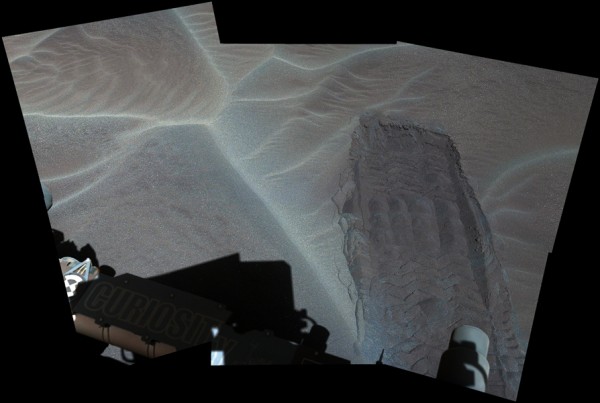[PHOTO] Mars Curiosity Rover Investigates Martian Sand Dunes
| Ana Verayo | | Dec 13, 2015 06:10 AM EST |
(Photo : NASA/JPL-Caltech/MSSS) A wheel track left by NASA's Curiosity Mars rover exposes underlying material in a shallow sand sheet in this Dec. 2, 2015, view from Curiosity's Mast Camera (Mastcam).
NASA's Curiosity rover finally reached another target destination on Mars, exploring the two story high sand dunes that are located on the lower base of Mount Sharp as it will start its new investigation of these remarkable features.
These new images are the first ever ones to provide a detailed view of these Martian dunes for further investigation. Curiosity's mission is to extract some samples of material that are found in the dunes for further testing and analysis using its suite of onboard scientific instruments.
Like Us on Facebook
The rover's new images of the dunes reveal a rippled surface taken from a site known as High Dune which is also found in the region called Bagnold Dunes in the northwestern part of Mount Sharp including a photo of the rover's wheel track that exposed the material underneath the surface of the sand sheets.
Using the onboard Mast Camera (Mastcam), the rover captured photos of the dunes during its exploration period on November 27, where the rover will determine the significant changes at the dunes over time. NASA already obtained observations from its Mars Reconnaissance Orbiter from lower orbit that revealed that the edges of each dune apparently move as much as three feet every year.
Curiosity rover landed on Mars in August 2012 where it has been travelling around the base of Mount Sharp inside Gale Crater, after it completed an investigation of outcroppings within the area of its landing site. In 2014, it finally arrived at Mars' highest point, Mount Sharp, where its main mission is to examine the higher layers in the central peak of the crater.
Mount Sharp is about three miles high where the rover is also investigating the lowest sediment layers that already exposed evidence for water that fills a "lake" on the Red Planet and then evaporates after during Martian seasons.
The ongoing NASA's Mars Science Laboratory Project's goal is for the Martian rover to search for ancient environments for clues about the Red Planet's evolutionary past and to also determine potential habitable sites on Mars. NASA also aims to send humans to Mars by the 2030s.
TagsNASA mars curiosity rover, sand dunes curiosity rover mars, mars sand dunes, Curiosity Rover, Mars
©2015 Chinatopix All rights reserved. Do not reproduce without permission
EDITOR'S PICKS
-

Did the Trump administration just announce plans for a trade war with ‘hostile’ China and Russia?
-

US Senate passes Taiwan travel bill slammed by China
-

As Yan Sihong’s family grieves, here are other Chinese students who went missing abroad. Some have never been found
-

Beijing blasts Western critics who ‘smear China’ with the term sharp power
-

China Envoy Seeks to Defuse Tensions With U.S. as a Trade War Brews
-

Singapore's Deputy PM Provides Bitcoin Vote of Confidence Amid China's Blanket Bans
-

China warns investors over risks in overseas virtual currency trading
-

Chinese government most trustworthy: survey
-

Kashima Antlers On Course For Back-To-Back Titles
MOST POPULAR
LATEST NEWS
Zhou Yongkang: China's Former Security Chief Sentenced to Life in Prison

China's former Chief of the Ministry of Public Security, Zhou Yongkang, has been given a life sentence after he was found guilty of abusing his office, bribery and deliberately ... Full Article
TRENDING STORY

China Pork Prices Expected to Stabilize As The Supplies Recover

Elephone P9000 Smartphone is now on Sale on Amazon India

There's a Big Chance Cliffhangers Won't Still Be Resolved When Grey's Anatomy Season 13 Returns

Supreme Court Ruled on Samsung vs Apple Dispute for Patent Infringement

Microsoft Surface Pro 5 Rumors and Release Date: What is the Latest?










